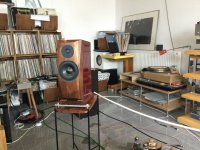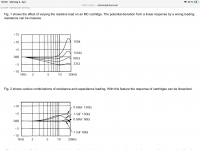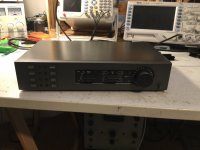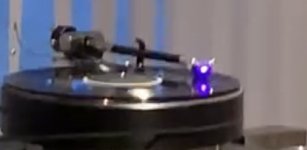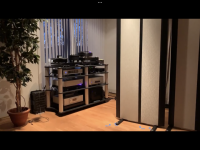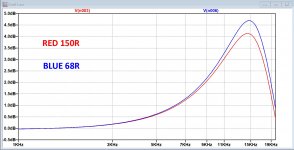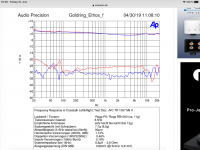As far as I understand the shading paddle is lower in moving mass then the coils of a MC cartridge.
Sure the needle and the cantilever has approximately the same mass.
To judge tonal balance I can compare the 003 to a Goldring Ethos that I have in another table that errs on the warm side. Certainly the 003 does not like a system that is already on the bright side. I had to change the speakers to a pair of Joachim Gerhard Collection Vitesse that has a bit of a forgiving sound without sacrificing detail too much.
By the way it is easy to damp the high frequency peak in a conventional MC cartridge.
The loading resistor has to be much smaller that what a MM cartridge needs and the capacitor is corresponding much higher.
Sure the needle and the cantilever has approximately the same mass.
To judge tonal balance I can compare the 003 to a Goldring Ethos that I have in another table that errs on the warm side. Certainly the 003 does not like a system that is already on the bright side. I had to change the speakers to a pair of Joachim Gerhard Collection Vitesse that has a bit of a forgiving sound without sacrificing detail too much.
By the way it is easy to damp the high frequency peak in a conventional MC cartridge.
The loading resistor has to be much smaller that what a MM cartridge needs and the capacitor is corresponding much higher.
Attachments
I have Adjust Plus from Feikert.
Another way to change the tonal balance is using a preamp with a really good tone control like the QUAD 34 that I am currently renovating. It sounded better then I expected though right out of the box.
i have the model with the famous black velvet Alps potmetets.
Another way to change the tonal balance is using a preamp with a really good tone control like the QUAD 34 that I am currently renovating. It sounded better then I expected though right out of the box.
i have the model with the famous black velvet Alps potmetets.
Attachments
Jan,But isn't the moving mass just the same as a 'normal' cartridge? As I read it, they pick off the vibrations of the shank by optical means, but the shank still vibrates normally from following the groove.
What they bypass is the conversion of the movements to the core output, MM or MC.
I can understand that they can set the output level almost arbitrarily high, noise allowing.
But the mass still has to be moved, because they need that to pick up optically with a reflective surface on the shank,.
Jan
Yes, the big difference is not in the needle and cantilever mass but in the transfer function.
A magnetic transfer by the needle movement is velocity driven while an optical transfer is displacement driven.
Hans
Just found this video from 2019 ( some screenshoots I can send here )
When I adjusted and listened to a DS Audio cartridge in my Arm on some turntable This was my impression:
I remember the sound to be very detailed and dynamical very impressive also open during complex musical material like old bombastic orchestral Rock and Band recordings. I found tonality was not wrong, but I missed for classical music the low level details in the tonality related character of instrumens .
It just lacked there and I have more correct instrument reproduction with super high end conventional cartridges but only with super refined phonostages. So for the quite high High End Audio price it gives a very open and detailed impression, but for classical music, the one needs also be able to give the tonal form of fading tones , there I find great phonastages with conventional cartridges superior. I do look forward to Joachims take on the PhonoStage build
Nevertheless it sure opens up any muddy sound
When I adjusted and listened to a DS Audio cartridge in my Arm on some turntable This was my impression:
I remember the sound to be very detailed and dynamical very impressive also open during complex musical material like old bombastic orchestral Rock and Band recordings. I found tonality was not wrong, but I missed for classical music the low level details in the tonality related character of instrumens .
It just lacked there and I have more correct instrument reproduction with super high end conventional cartridges but only with super refined phonostages. So for the quite high High End Audio price it gives a very open and detailed impression, but for classical music, the one needs also be able to give the tonal form of fading tones , there I find great phonastages with conventional cartridges superior. I do look forward to Joachims take on the PhonoStage build
Nevertheless it sure opens up any muddy sound
Attachments
Joachim,What cartridge was that ? In the meantime DS buils several models.
I have the same question regarding the graph you have shown in #11761.
There is a huge 15dB difference at 20Khz between 33R and 100K in the upper graph.
Loading my MC Cart with either 100R or 47K, only shows a slight change in level because of the Cart's source impedance, but FR with only 100pF load hardly changes.
When trying to replicate the curve from #11761 with 150R + 0.68uF, I need a Cart with Rs=10R and a rather high coil inductance of 140uH.
However, while matching curves to 0dB@1Khz as you did, when changing the load from 150R to 68R as shown in your graph, FR changes BUT in the opposite direction, not -3dB@15Khz lower but +0.5dB@15Khz higher, see attachment ??
So my question is, what Cart could it possibly be that you used and how was the measurement performed ?
Hans
Attachments
I did not do the measurements. I just coppied this graph from the Internet and i do not know what cartridge they used. If that has caused some confusion i am really sorry of that. On the other side it is interting how imput impedance and capacitive loading does not only work with MM sytemsa but also with Mc systems.
Thx for answerring.I did not do the measurements. I just coppied this graph from the Internet and i do not know what cartridge they used. If that has caused some confusion i am really sorry of that. On the other side it is interting how imput impedance and capacitive loading does not only work with MM sytemsa but also with Mc systems.
Yes, different loading can have quite some effect on the MM cart’s measured FR, but in genereal very little effect on MC carts because of the ultra low inductance.
Those graphs are far beyond reality.
Hans
I feel like I'm trespassing here, but I have a request.
I was fortunate in securing a set of paradise boards and I've recently finished the build (possibly the last one on the planet).
I was also given one solitary Calvin buffer board along with the purchase. Very kind of the seller but also now rather frustrating.
It was suggested that I try here to see if anyone has one lonely and forgotten spare board left in a drawer somewhere.
I was fortunate in securing a set of paradise boards and I've recently finished the build (possibly the last one on the planet).
I was also given one solitary Calvin buffer board along with the purchase. Very kind of the seller but also now rather frustrating.
It was suggested that I try here to see if anyone has one lonely and forgotten spare board left in a drawer somewhere.
Calvin buffer board along
I have some ... free if you pay shipping and I will send you two PCBs.
Some time ago we talked about the measurements on a Goldring Ethos that where not fully logical. Here are measurements done by Peter Schüller. For a very long time his lab did measurements for Audio and Stereoplay, well known Hi-Fi magazines in Germany. I trust him.
Attachments
Hi Joachim,
He is as far as I know also the guy who does the measurements for lowbeats.de. His measurements seems to be of very good standard.
Anyways, the Goldring seems to have very flat frequency response and good tracking ability.
I don't know the quality of the measurements in Hi-fi News, but a lot of expensive cartridges seems to have rising frequency response which I suspect is done on purpose to make them sound more "fresh" and CD like.
He is as far as I know also the guy who does the measurements for lowbeats.de. His measurements seems to be of very good standard.
Anyways, the Goldring seems to have very flat frequency response and good tracking ability.
I don't know the quality of the measurements in Hi-fi News, but a lot of expensive cartridges seems to have rising frequency response which I suspect is done on purpose to make them sound more "fresh" and CD like.
Thanks for posting. Stereo Magazine tested this too. Their limited test data, no info on tracking or channel separation, is here:Some time ago we talked about the measurements on a Goldring Ethos that where not fully logical. Here are measurements done by Peter Schüller. For a very long time his lab did measurements for Audio and Stereoplay, well known Hi-Fi magazines in Germany. I trust him.
https://stereo-magazine.com/review/goldring-ethos-review
Horizontal compliance feom both reports is similar, approx 18 nm/ mN vs. 15 nm/mN for Stereo Magazine. However, the more important vertical compliance is not measured. Joachim, can you ask Peter if he has data on vertical compliance?
Overall looks like a nice cartridge, but much more expensive bthan the OC9 Mk 2.
Last edited:
